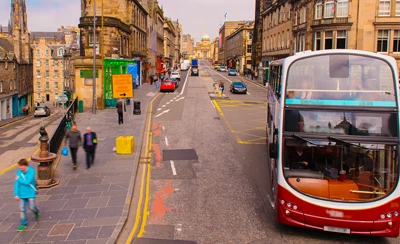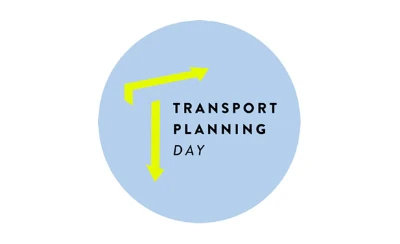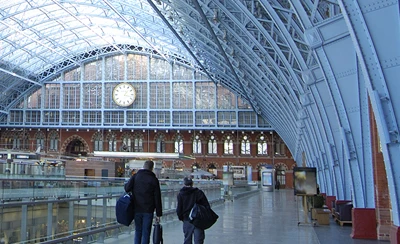Transport Secretary Grant Shapps has announced ‘£2b package’ of funding to promote walking and cycling
The announcement made by the Secretary of State for Transport during the Government’s daily Coronavirus briefing on Saturday 9th May 2020 aims to promote walking and cycling as the centre and clear focus of the strategy to address the Covid-19 challenge of social distancing and the associated impact on capacity of public transport services.
The announcement points to legislation that allows for new road and street signage and directs Local Authorities to make changes to aid walk/cycle trips as social distancing of 2m between persons becomes a new (temporary) norm.
“None of these measures are new – they are interventions that are a standard part of the traffic management toolkit, but a step-change in their roll-out is needed to ensure a green restart.” – DfT
As part of the announcement it was included that e-Scooter trials accelerated and expanded. These devices are currently not permitted for use either on or off-carriageway within the public highway but will be permitted under the trial with a maximum speed of around 15mph.
Most of the funding commitments contained within the announcement appear to relate to previously committed funding promises, though a number of these are being accelerated to tackle current issues of Covid-19 and social distancing.
Coronavirus has had a truly terrible healthcare impact on the UK and the loss of life arising from the virus is tragic with our thoughts going to all those families who have been impacted by the loss of friends and relatives. The focus of this post relates to transport and related economic impacts of the situation.
Whilst the economic implications of the virus require the re-opening of our town and cities as early as possible, social distancing, along with other measures, will be required to keep down the spread of the virus until such time as a vaccine is widely available.
How will Towns and Cities Respond:
Most footways in the UK are 2m wide – if the space between persons for social distancing should be at least 2m this immediately identifies that persons would not have sufficient space to pass one-another without one of them entering the carriageway or footways being made one-way.
The re-opening of high street stores will also in the short-term see social distancing applied, thus reduced capacities inside and a likelihood of queuing outside to manage demand, like we currently see at supermarkets. Where there are narrow footways this creates an issue where closure of on-street car parking or removal of running lanes with traffic management may be required to allow for safe social distancing.
Social distancing applied on public transport is anticipated to reduce capacity of services by around 85% even when allowing for a full-service timetable operation at pre-Covid-19 levels. As well as the challenge of severely reduced public transport capacity, some urban areas have high levels of households without having access to a car, thus further limiting mode choice for travel. Some of the most deprived areas where car ownership is low are located further out-of-centre where there is a disproportionately high reliance on public transport – these areas with the poorest residents will be the most directly impacted by the requirements of social distancing.
Short Term Changes and Challenges:
Some Local Authorities, including one in the Northeast with who we discussed their emerging Covid-19 response strategy, are anticipating around a 33% reduction in overall demand for travel once the period of lockdown is eased and high street shops, offices and schools start re-opening. This is allowing for those most vulnerable to the virus to remain at home along with others who, having now been exposed to the possibility of home working, find working at home a practical solution rather than undertaking a daily commute to an office. Other factors reducing overall travel demand include an increase in online grocery shopping (discussed in more detail below) and a reduction in physical leisure activities.
However, with public transport capacity reduced by around 85% due to social distancing, these journeys will need to be replaced by other modes, such as walking, cycling or car trips. An initial Traffic management response would be to remove areas of parking, street furniture, one-way streets, coned-off carriageway to widen footways and provide additional cycle lanes within urban centres.
In order to consider the potential repercussions of such a drastic reduction in public transport capacity, Table 1 reviews pre-Covid-19 travel patterns into Manchester City Centre on a typical Weekday morning. This shows the potential impacts arising from a reduction in the overall demand for travel, whilst incorporating the significant reduction in public transport journeys:
Table 1 – Manchester City Centre Weekday AM Peak Period Arrivals by Mode:

The numbers presented above are based on early arbitrary assumptions (using a method applied by one Northeast Local Authority) to provide a broad view of the potential impacts in order to identify the emerging challenges. Other factors such as split-shift working, staggered start times etc are not considered at this stage
The data suggests that even allowing for car usage at pre-covid-19 levels, a shortfall of 24.5k trips could occur. It would take a doubling of walking trips and over a six-fold increase in cycling to achieve the total overall 33% reduction in demand that might arise with limited PT capacity, thus highlighting the scale of the challenge.
With public transport capacity being so low will privately operated bus services be commercially viable? Light Rail systems have already had some central government funding to continue but the capacity reductions will remain an existential threat so long as social distancing continues. An option already applied to the rail industry is essentially nationalisation in order to maintain service provision.
A number of local authorities are actively designing traffic management solutions for short term changes to public realm to aid walking and cycling in urban centres and considering other measures such as amending traffic signals to increase pedestrian crossing stage times for both increased demand and greater spacing for social distancing.
Medium to Long Term Changes:
There are a growing number of voices suggesting that one of the few positives arising from the covid-19 situation is the potential to provide a real impetus to increasing the numbers of walking and cycling trips. This links in with longer-term air quality and general environmental and health aspirations to improve the pedestrian and cycle environment in towns and cities, as well as around schools and local/neighbourhood centres and to get more people moving ‘actively’.
Adapting a number of the short-term measures to increase cycle provision (routes and parking), have more pedestrian-only areas and the relocation of car parking further out-of-centre is a likely outcome.
Beyond the urban centres it is likely that further changes to the environment will be made, particularly around schools and neighbourhood centres, to enhance opportunities for walking and cycling and to avoid the transfer away from public transport to be established as additional car use. One method previously trialled across Europe has been to encourage ‘low traffic neighbourhoods’.
One trial in Barcelona, known as a ‘superblock’ has been established for several years and has seen a number of positive outcomes for walking and cycling, including environmental noise and air quality benefits, with road space reallocated for footways, cycle routes and even play areas and picnic benches. These schemes often include one-way streets and limit access for vehicles, an example of the Poblenou ‘Superblock’ is shown at Figure 1.
Figure 1 – Layout of the Poblenou ‘Superblock’ Barcelona

In the medium term it is likely that an overall reduction in travel demand will remain, as there is no fixed timescale on a vaccine on one side and on the other alternative provision of services, such as the capacity of online grocery shopping, has increased significantly.
Table 2 summarises the recent increase in online grocery shopping delivery capacity in the UK based on the actions of five of the main operators in the sector.
Table 2 – UK Online Grocery Shopping Delivery Capacity

The increase in online capacity for home grocery delivery has more than doubled in just a few weeks, if this capacity is even just maintained it will have a significant impact on grocery shopping trends across the country, whilst that industry believes there is the potential to further increase this capacity moving forward.
Implications for New Developments:
One of the first implications for schemes currently in progress would be a design review of schemes in terms of parking provision, footways and pedestrian access routes and cycle provision in terms of routes and parking/facility provision.
1m wide footways have never been ideal but have been included in schemes previously, clearly this is something that is not appropriate whilst social distancing applies and moving forward is not something that would promote access or increasing demand for travel by this mode.
Cycle facilities need to be fit for purpose to serve a potentially exponential increase in demand – this would include appropriate parking and associated facilities such as showers and lockers.
Site access design priorities may well be lastingly changed to further prioritise walk/cycle and be less dedicated to car use for all types of developments. For example, the designing housing development accesses and internal arrangements around the need to accommodate refuse vehicles within significant areas of hardstanding, for vehicles that arrive once per week, must finally change.
Car parking provision (parking standards) are likely to stay broadly in their current form given the short to mid-term reduction in public transport availability.
There is the possibility that Local Authorities may seek additional S106 or CIL contributions for sustainable access. It could be that this is in place of further funding for off-site highway capacity improvements.
Summary:
Sustainable travel is potentially one of the few areas where Covid-19 may lead to some positive outcomes, with significant action to promote walking and cycling being taken by the government at the national level and encouraging Local Authorities to take action on the ground.
Given the implications with public transport and social distancing in the short-term at least, car use is still going to be fundamental for the economy and any economic recovery, therefore it is vital that this mode of travel is not forsaken for walk and cycle and appropriate interventions at the correct locations are taken.
Moving forward, public transport must be preserved for the post-Covid-19 future if further climate change and air quality targets are to be achieved with a key focus on the value of Travel Plans promoting real travel options rather than being viewed as a ‘tick-box’ exercise.
For new developments, supporting Transport Assessments are going to require clear and detailed pre-application scoping discussions with Local Authorities where existing traffic data will be required in the absence of being able to undertake any new data collection in the near future.








